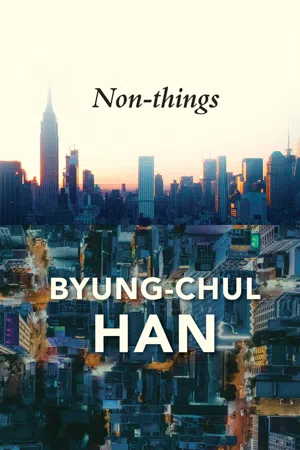
- English
- ePUB (mobile friendly)
- Available on iOS & Android
About this book
We no longer inhabit earth and dwell under the sky: these are being replaced by Google Earth and the Cloud. The terrestrial order is giving way to a digital order, the world of things is being replaced by a world of non-things – a constantly expanding 'infosphere' of information and communication which displaces objects and obliterates any stillness and calmness in our lives.
Byung-Chul Han's critique of the infosphere highlights the price we are paying for our growing preoccupation with information and communication. Today we search for more information without gaining any real knowledge. We communicate constantly without participating in a community. We save masses of data without keeping track of our memories. We accumulate friends and followers without encountering other people. This is how information develops a form of life that has no stability or duration. And as we become increasingly absorbed in the infosphere, we lose touch with the magic of things which provide a stable environment for dwelling and give continuity to human life. The infosphere may seem to grant us new freedoms but it creates new forms of control too, and it cuts us off from the kind of freedom that is tied to acting in the world.
This new book by one of the most creative cultural theorists writing today will be of interest to a wide readership.
Frequently asked questions
- Essential is ideal for learners and professionals who enjoy exploring a wide range of subjects. Access the Essential Library with 800,000+ trusted titles and best-sellers across business, personal growth, and the humanities. Includes unlimited reading time and Standard Read Aloud voice.
- Complete: Perfect for advanced learners and researchers needing full, unrestricted access. Unlock 1.4M+ books across hundreds of subjects, including academic and specialized titles. The Complete Plan also includes advanced features like Premium Read Aloud and Research Assistant.
Please note we cannot support devices running on iOS 13 and Android 7 or earlier. Learn more about using the app.
Information
Views of Things
Quelle étonnante servilité! Les choses sont sages comme des images. A la lettre: comme des images! Elles n’inquiètent plus du tout les hommes. Aussi, même du coin de l’oeil, ne les considerènt-ils plus.[What an astounding submissiveness! The things are tame, like pictures. Literally like pictures! They no longer worry people at all. And thus they are no longer noticed by them, not even out of the corners of their eyes.1]D’abord la chose est l’autre, le tout autre qui dicte ou qui écrit la loi, … une injonction infiniment, insatiablement impérieuse à laquelle je dois m’assujettir.[Beforehand, the thing is the other, the entirely other which dictates or which writes the law, … an infinitely, insatiably imperious injunction to which I ought to subject myself.]2
The Villainy of Things
The Reverse of Things
The fire in the stove burns even when we’re not around. Therefore, we say, it must have been burning in the meantime, since the room is now warm. Yet that is not certain, and what the fire was doing before, what the furniture was doing during our absence, is obscure. No proposition about it ...
Table of contents
- Cover
- Title Page
- Copyright
- Preface
- From Things to Non-things
- From Possessing to Experiencing
- Smartphone
- Selfies
- Artificial Intelligence
- Views of Things
- Stillness
- Excursus on the Jukebox
- End User License Agreement